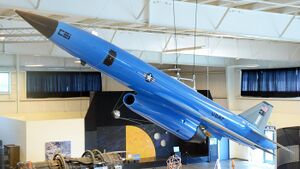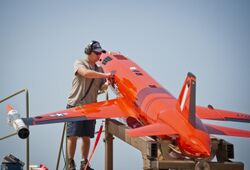Engineering:Composite Engineering BQM-167 Skeeter
| BQM-167 Skeeter | |
|---|---|

| |
| BQM-167 Skeeter target drone | |
| Role | Unmanned target drone |
| National origin | United States |
| Manufacturer | Composite Engineering Inc. Kratos Defense & Security Solutions |
| Primary user | United States Air Force |
| Number built | 37[1] |
The Composite Engineering BQM-167 Skeeter is a subscale aerial target (drone) developed and manufactured by Composite Engineering Inc. (acquired by Kratos Defense & Security Solutions) and operated by the United States Air Force and certain international customer air forces (designation BQM-167i). It replaced the Beechcraft MQM-107 Streaker.
Design and development
The BQM-167 was developed and manufactured by Composite Engineering Inc. (now part of Kratos Defense & Security Solutions), and is constructed of carbon fiber and epoxy-based materials.[1][2]
Two prototype targets were built and test flown in 2001. The BQM-167A was selected as the next-generation Air Force subscale aerial target in July 2002. A total of six targets were built for use during the flight performance demonstration (FPD) phase with its first flight 8 December 2004. A total of 13 FPD launches were made into March 2006.[1]
First acceptance testing was completed in August 2006, then pre-operational testing consisted of 13 test flights using production targets from August 2006 - June 2007. The first BQM-167 air-to-air missile live-fire mission took place 7 February 2007. Initial Operational Capability was achieved in 2008. Each target cost US$570,000.[1]
Operational history
The 82nd Aerial Targets Squadron operates and maintains the target at Tyndall Air Force Base , Florida.
The drone is land-launched using a rocket assisted takeoff and launched from a rail system, and recovered on land or sea using a parachute system. After assessment and refurbishment, the drone is placed back into service.[1]
The USAF has had 37 in inventory.[1]
On 19 March 2021, a BQM-167 washed ashore in Boynton Beach, Florida after a weapon systems evaluation.[3]
Variants
UTAP-22 Mako
On 23 November 2015, Kratos completed the second flight of its self-funded Unmanned Tactical Aerial Platform (UTAP-22), a development of the BQM-167A converted into a low-cost unmanned combat aerial vehicle (UCAV). The test involved collaborative airborne operations with a manned AV-8B Harrier fighter for 94 minutes demonstrating command and control through a tactical data-link, autonomous formation flying with the AV-8B, and transfer of UTAP-22 control between operators in a tactical network and then to an independent control link.[4] The 6.1 m (21 ft)-long turbojet-powered aircraft can travel at Mach 0.91 (693 mph; 1,115 km/h) up to an altitude of 50,000 ft (15,000 m) with a maximum range of 1,400 nmi (1,600 mi; 2,600 km) and an endurance of three hours. It can carry a 159 kg (351 lb) internal payload, a 227 kg (500 lb) external payload, and has a 45 kg (99 lb)-capable weapon hardpoint on each wing. The platform is recoverable on land or at sea using a parachute system.[5][6] In May 2017, the UTAP-22 received the official name Mako.[7] The aircraft costs between $2-$3 million.[8]
Operators
 United States
United States
.
- Republic Of Singapore Air Force[9]
.
 Sweden
Sweden
- Swedish Defence Materiel Administration[10]
Specifications
Data from
General characteristics
- Crew: None
- Length: 20 ft 0 in (6.1 m)
- Wingspan: 10 ft 6 in (3.2 m)
- Height: 4 ft 0 in (1.2 m)
- Empty weight: 690 lb (313 kg)
- Max takeoff weight: 2,050 lb (930 kg)
- Powerplant: 1 × 1x MicroTurbo Tri 60-5+ turbojet, 990 lbf (4.4 kN) thrust
Performance
- Maximum speed: 600 kn (690 mph, 1,100 km/h) (sea level)
- Cruise speed: 230 kn (260 mph, 430 km/h) (sea level)
- Service ceiling: 50,000 ft (15,000 m) MSL 50 ft AGL min. / 8 m min.
9 G turns; recovered by a parachute recovery system either from land or water
Avionics
IR and RF Tow Targets; IR and RF Wing Pods;[clarification needed] Chaff / Flare Dispensing; Vector & Scalar Scoring
References
- ↑ 1.0 1.1 1.2 1.3 1.4 1.5 1.6 BQM-167A Air Force Subscale Aerial Target, USAF, 2009-05-20, accessed 2017-02-23
- ↑ BQM-167A brochure, KratosUSD, accessed 2017-02-23
- ↑ "Military Drone Washed Ashore On Boynton Beach". https://miami.cbslocal.com/2021/03/19/military-drone-washed-ashore-boynton-beach/.
- ↑ Kratos Completes Second Flight of Tactical Unmanned Aircraft - Ainonline.com, 9 December 2015
- ↑ Kratos breaking into the unmanned combat air vehicle market - Flightglobal.com, 5 May 2016
- ↑ Kratos gets green light to market potentially-armed Mako ‘loyal wingman’ drone to allies. Defense News. 1 May 2018.
- ↑ USAF Research Lab Has Released This Image Of Its Low-Cost Stealthy Drone - Thedrive.com, 19 May 2017
- ↑ Kratos’ Mako drone approved for sale to foreign militaries. Flight International. 15 March 2018.
- ↑ Desk, Business (4 August 2011). "Government of Singapore Purchases High Speed Aerial Target Drones - The Global Herald" (in en-US). https://theglobalherald.com/business/government-of-singapore-purchases-high-speed-aerial-target-drones/.
- ↑ "Sammansvetsat team i FMV:s målrobotverkstad | Affärstidningen Näringsliv". April 2019. https://naringsliv.se/legacy/sammansvetsat-team-i-fmvs-malrobotverkstad-2/.
- ↑ BQM-167A Air Force Subscale Aerial Target, Kratos, accessed 2018-08-08
External links
 |



